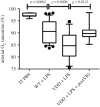Vitamin D and COVID-19: evidence and recommendations for supplementation
- PMID: 33489300
- PMCID: PMC7813231
- DOI: 10.1098/rsos.201912
Vitamin D and COVID-19: evidence and recommendations for supplementation
Abstract
Vitamin D is a hormone that acts on many genes expressed by immune cells. Evidence linking vitamin D deficiency with COVID-19 severity is circumstantial but considerable-links with ethnicity, obesity, institutionalization; latitude and ultraviolet exposure; increased lung damage in experimental models; associations with COVID-19 severity in hospitalized patients. Vitamin D deficiency is common but readily preventable by supplementation that is very safe and cheap. A target blood level of at least 50 nmol l-1, as indicated by the US National Academy of Medicine and by the European Food Safety Authority, is supported by evidence. This would require supplementation with 800 IU/day (not 400 IU/day as currently recommended in UK) to bring most people up to target. Randomized placebo-controlled trials of vitamin D in the community are unlikely to complete until spring 2021-although we note the positive results from Spain of a randomized trial of 25-hydroxyvitamin D3 (25(OH)D3 or calcifediol) in hospitalized patients. We urge UK and other governments to recommend vitamin D supplementation at 800-1000 IU/day for all, making it clear that this is to help optimize immune health and not solely for bone and muscle health. This should be mandated for prescription in care homes, prisons and other institutions where people are likely to have been indoors for much of the summer. Adults likely to be deficient should consider taking a higher dose, e.g. 4000 IU/day for the first four weeks before reducing to 800 IU-1000 IU/day. People admitted to the hospital with COVID-19 should have their vitamin D status checked and/or supplemented and consideration should be given to testing high-dose calcifediol in the RECOVERY trial. We feel this should be pursued with great urgency. Vitamin D levels in the UK will be falling from October onwards as we head into winter. There seems nothing to lose and potentially much to gain.
Keywords: COVID-19; immunology; vitamin D.
© 2020 The Authors.
Conflict of interest statement
M.H. and D.T. have received speaking honoraria from Thornton Ross. No other competing interests.
Figures








Similar articles
-
Vitamin D supplementation for term breastfed infants to prevent vitamin D deficiency and improve bone health.Cochrane Database Syst Rev. 2020 Dec 11;12(12):CD013046. doi: 10.1002/14651858.CD013046.pub2. Cochrane Database Syst Rev. 2020. PMID: 33305822 Free PMC article.
-
Vitamin D supplementation for sickle cell disease.Cochrane Database Syst Rev. 2020 May 28;5(5):CD010858. doi: 10.1002/14651858.CD010858.pub3. Cochrane Database Syst Rev. 2020. PMID: 32462740 Free PMC article.
-
Dose-response effects of supplementation with calcifediol on serum 25-hydroxyvitamin D status and its metabolites: A randomized controlled trial in older adults.Clin Nutr. 2018 Jun;37(3):808-814. doi: 10.1016/j.clnu.2017.03.029. Epub 2017 Mar 31. Clin Nutr. 2018. PMID: 28433267 Clinical Trial.
-
Rapidly Increasing Serum 25(OH)D Boosts the Immune System, against Infections-Sepsis and COVID-19.Nutrients. 2022 Jul 21;14(14):2997. doi: 10.3390/nu14142997. Nutrients. 2022. PMID: 35889955 Free PMC article.
-
Effect of vitamin D3 seasonal supplementation with 1500 IU/day in north Italian children (DINOS study).Ital J Pediatr. 2019 Jan 28;45(1):18. doi: 10.1186/s13052-018-0590-x. Ital J Pediatr. 2019. PMID: 30691521 Free PMC article.
Cited by
-
Perspective: Vitamin D supplementation prevents rickets and acute respiratory infections when given as daily maintenance but not as intermittent bolus: implications for COVID-19.Clin Med (Lond). 2021 Mar;21(2):e144-e149. doi: 10.7861/clinmed.2021-0035. Epub 2021 Feb 16. Clin Med (Lond). 2021. PMID: 33593830 Free PMC article.
-
Does vitamin D supplementation reduce COVID-19 severity?: a systematic review.QJM. 2022 Oct 25;115(10):665-672. doi: 10.1093/qjmed/hcac040. QJM. 2022. PMID: 35166850 Free PMC article.
-
Patterns of Dietary Supplement Use during the COVID-19 Pandemic in Poland: Focus on Vitamin D and Magnesium.Nutrients. 2024 Sep 24;16(19):3225. doi: 10.3390/nu16193225. Nutrients. 2024. PMID: 39408194 Free PMC article.
-
Vitamin D: A Potential Mitigation Tool for the Endemic Stage of the COVID-19 Pandemic?Front Public Health. 2022 Jun 10;10:888168. doi: 10.3389/fpubh.2022.888168. eCollection 2022. Front Public Health. 2022. PMID: 35757617 Free PMC article. Review.
-
Critical care nutrition and COVID-19: a cause of malnutrition not to be underestimated.BMJ Nutr Prev Health. 2021 May 27;4(1):342-347. doi: 10.1136/bmjnph-2021-000271. eCollection 2021. BMJ Nutr Prev Health. 2021. PMID: 34308142 Free PMC article.
References
LinkOut - more resources
Full Text Sources

